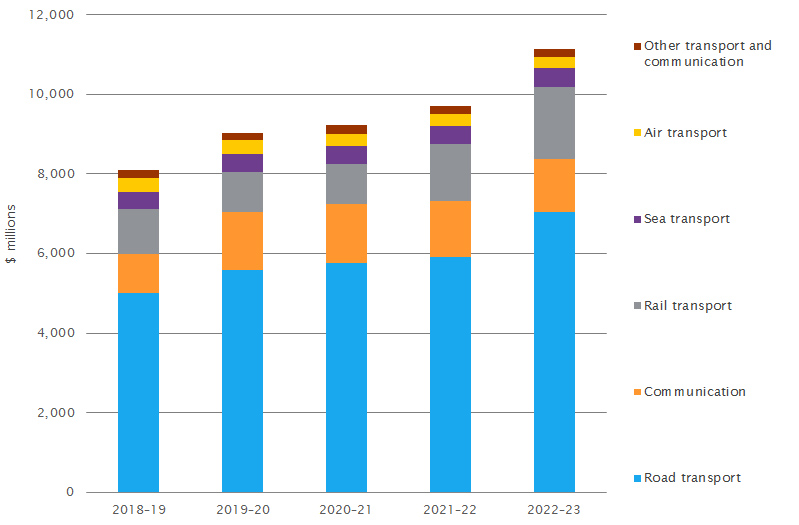Dr Jonathon Deans
Australian Government expenditure on communications and
transport infrastructure in 2019–20 is estimated to be $9.0 billion,
representing 1.8 per cent of the Australian Government’s total expenditure.
Expenditure included under this function includes:
Table 1: total
communications and transport expenditure
| ($ million) |
2018–19
(est.) |
2019–20
(est.) |
2020–21
(est.) |
2021–22
(proj.) |
2022–23
(proj.) |
| Communication |
964 |
1 466 |
1 478 |
1 394 |
1 341 |
| Rail transport |
1 134 |
1 001 |
991 |
1 439 |
1 818 |
| Air transport |
355 |
350 |
317 |
300 |
277 |
| Road transport |
5 016 |
5 587 |
5 773 |
5 925 |
7 033 |
| Sea transport |
438 |
444 |
448 |
450 |
475 |
| Other transport and communication |
198 |
190 |
219 |
209 |
205 |
| Total |
8 105
|
9 038
|
9 226
|
9 717
|
11 149
|
Note: Figures may not add due to rounding.
Source: Australian Government, Budget
strategy and outlook: budget paper no. 1: 2019–20, 2019, p. 5–31.
Figure 1: breakdown of communications and transport
infrastructure expenditure

Source: Australian
Government, Budget
strategy and outlook: budget paper no. 1: 2019–20, 2019, p. 5–31.
Total expenditure on
transport and communications is expected to grow by 15 per cent in real terms
between 2019–20 and 2022–23, primarily reflecting increases in funding for rail
and roads infrastructure.
Table 2: significant policy announcements
| $million |
2018–19 |
2019–20 |
2020–21 |
2021–22 |
2022–23 |
| Building Better Regions Fund–round four |
- |
39.7 |
108.3 |
48.3 |
9.9 |
| Infrastructure Investment Program — New
South Wales infrastructure |
25.0 |
25.0 |
32.0 |
49.0 |
135.5 |
| Infrastructure Investment Program —
Queensland infrastructure investments |
- |
- |
5.0 |
105.0 |
203.0 |
| Infrastructure Investment Program — Road
Safety and Upgrade Package |
- |
200.0 |
200.0 |
200.0 |
200.0 |
| Infrastructure Investment Program—Roads
of Strategic Importance— next priorities |
- |
- |
100.0 |
150.0 |
200.0 |
| Infrastructure Investment Program—Urban
Congestion Fund—next priorities |
- |
400.0 |
400.0 |
400.0 |
400.0 |
| Infrastructure Investment
Program—Western Australian infrastructure |
- |
17.5 |
60.0 |
233.5 |
132.0 |
Source: Australian Government, Budget
strategy and outlook: budget paper no. 2: 2019–20, 2019, p. 123–146.
Transport
The Government has announced that infrastructure spending
will increase to $100 billion over 10 years but there has been comparatively
little change to spending over the current budget period:
Equity investments in
infrastructure projects, such as the Western Sydney Airport and Inland Rail, are not included as an
expense measure with the Budget.
Communications
The Regional
Broadband Scheme was announced in 2017 to fund certain loss-making NBN
services through a levy on profitable NBN services. The Government has reduced
the levy cap on the service from $10 to $7.10 per month per premises and has
provided certain exemptions. This has a negligible impact on the Budget. The
Scheme is the main driver of communications expenditure over the Budget
period.
All online articles accessed April 2019
For copyright reasons some linked items are only available to members of Parliament.
© Commonwealth of Australia

Creative Commons
With the exception of the Commonwealth Coat of Arms, and to the extent that copyright subsists in a third party, this publication, its logo and front page design are licensed under a Creative Commons Attribution-NonCommercial-NoDerivs 3.0 Australia licence.
In essence, you are free to copy and communicate this work in its current form for all non-commercial purposes, as long as you attribute the work to the author and abide by the other licence terms. The work cannot be adapted or modified in any way. Content from this publication should be attributed in the following way: Author(s), Title of publication, Series Name and No, Publisher, Date.
To the extent that copyright subsists in third party quotes it remains with the original owner and permission may be required to reuse the material.
Inquiries regarding the licence and any use of the publication are welcome to webmanager@aph.gov.au.
This work has been prepared to support the work of the Australian Parliament using information available at the time of production. The views expressed do not reflect an official position of the Parliamentary Library, nor do they constitute professional legal opinion.
Any concerns or complaints should be directed to the Parliamentary Librarian. Parliamentary Library staff are available to discuss the contents of publications with Senators and Members and their staff. To access this service, clients may contact the author or the Library‘s Central Enquiry Point for referral.